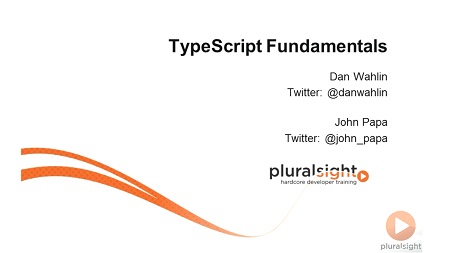English | MP4 | AVC 1024×768 | AAC 44KHz 2ch | 4h 25m | 0.98 GB
TypeScript Fundamentals walks you through the key concepts and features that you need to know to get started with TypeScript, and use it to build large (and small) scale JavaScript applications. Updated March 25, 2016 for TypeScript 1.8.
This course has been updated as of March 25, 2016 for TypeScript 1.8. TypeScript is an open source language that provides support for building enterprise scale JavaScript applications. Although several patterns exist that can be used to structure JavaScript, TypeScript provides container functionality that object-oriented developers are familiar with, such as classes and modules. It also supports strongly-typed code to ensure inappropriate values aren’t assigned to variables in an application. This course will walk you through the key concepts and features that you need to know to get started with TypeScript, and use it to build enterprise scale JavaScript applications. You’ll learn the role that TypeScript plays as well as key features that will help jump-start the learning process.
Table of Contents
Getting Started with TypeScript
1 Course Introduction
2 Introduction
3 Why use TypeScript
4 TypeScript Features
5 TypeScript Syntax, Keywords, and Code Hierarchy
6 Tooling and Framework Options
7 Tooling and Framework Options TypeScript Playground
8 Tooling and Framework Options Visual Studio
9 Tooling and Framework Options Web Essentials
10 Tooling and Framework Options Sublime Text
11 Tooling and Framework Options TypeScript Compiler
12 Tooling and Framework Options NodeJS
13 Hello World Example
14 Hello World Example Creating a Class
15 Summary
Typing, Variables, and Functions
16 Overview
17 Grammar, Declarations, and Annotations
18 Type Inference
19 Grammar
20 Static and Dynamic Typing
21 Compile Time or Run Time
22 Ambient Declarations and Type Definition Files
23 The Any Type and Primatives
24 Applying Types
25 Objects
26 Functions
27 Arrow Functions and Debugging
28 Functions and Interfaces
29 Static Typing Recap
Classes and Interfaces
30 Introduction
31 Defining Classes
32 Demo Defining Classes
33 Demo Property Limitations
34 Casting and Type Definition Files
35 Demo Casting and Type Definition Files
36 Extending Types
37 Demo Extending Types
38 Using Interfaces
39 Demo Using Interfaces
40 Extending an Interface
41 Demo Extending an Interface
42 Summary
Modules
43 Overview
44 Identifying a Module
45 Creating an Internal Module
46 Internal Module Accessibility and IIFE
47 Named Modules
48 Extending Modules and Importing Shortcuts
49 Organizing Internal Modules
50 Separating Internal Modules
51 External Modules and Dependency Resolution
52 Module Dependencies
53 Importing External Modules Using AMD
54 Importing 3rd Party Libraries Using AMD
55 Modules Recap
Resolve the captcha to access the links!
